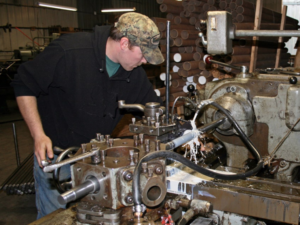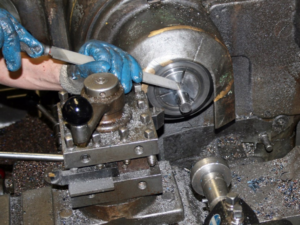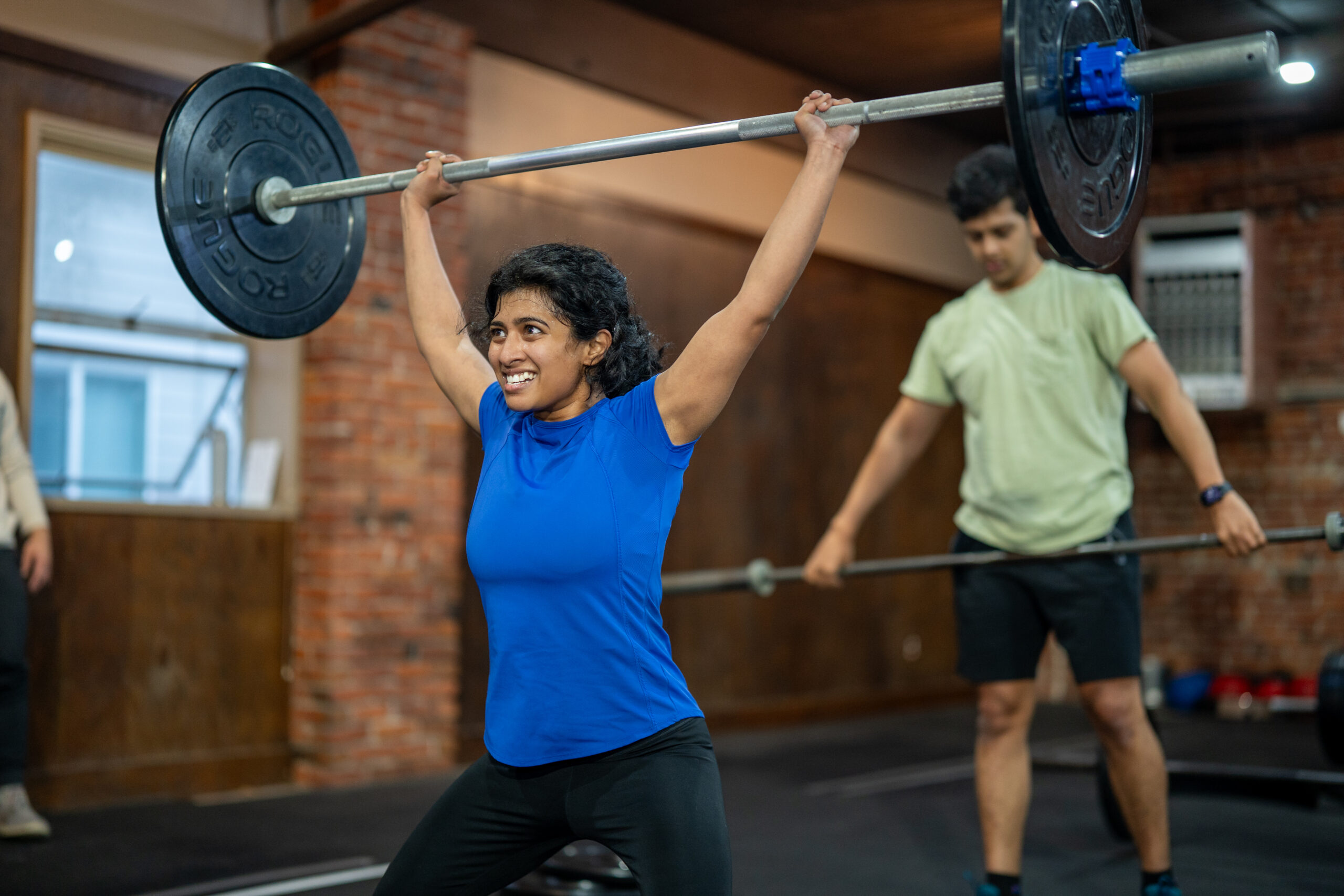The bar is the heart and soul of barbell training. A good bar is the most important piece of gym equipment you will use in a correctly designed strength training program. If you are buying it for your home gym, it is the purchase that will have the greatest bearing on the quality of your training experience. A cheap bar is not a pleasure to train with, and it may make some of your more critical exercises more difficult to do.
Barbell Varieties and Variables
The type of bar you buy should be determined by what you want to do with it. Many factors play into the quality of a bar, and understanding them is important to the informed consumer.
Olympic weightlifting bars are produced in training and competition grades and are designed to comply with International Weightlifting Federation specifications regarding markings and dimensions.
Powerlifting bars, again in either training or competition grade, are stiffer than weightlifting bars, since bar oscillation is not desirable in the squat, bench or deadlift. Specialized thicker bars for squats and longer bars for deadlifts are available and used in some federations.
“Multi-purpose” bars are produced for generalized strength training, gym use, and the institutional and scholastic markets. The surface of the bar can be finished in a variety of ways: chrome, zinc, black oxide or unfinished, or stainless steel can be used.
Thicknesses vary from 25 mm for women’s weightlifting bars to 1 3/8 inches for squat bars, on up to 3 inches for specialized fat bars designed for grip training. The most common length for general-purpose bars is 84 inches (7 feet) but they are available in lengths of 72, 60 and 48 inches for specific needs. They come in a variety of weights, from 5 kg to 60 pounds, with varied knurling depth and marking options; with bolt, snap ring or roller pin retainers; with bushing or needle-bearing sleeves; of domestic or foreign manufacture; and with expensive, mid-range or economy pricing.
Olympic weightlifting, however, has one international governing body and one set of equipment specifications. Several manufacturers produce bars for competition and training, with separate dimensions for men’s and women’s equipment. In most cases the grade and style of a given manufacturer’s men’s and women’s bars are very similar, if not the same. The major differences are the weight (20 kg for men and 15 kg for women) and diameter (28 mm for men and 25 mm for women).
Weightlifting bars are smaller in diameter than powerlifting bars. A smaller grip surface is necessary to allow the fast rotation of the bar, since the smaller diameter rotates at a higher angular velocity, and the smaller diameter makes it easier to assume the hook grip favored by weightlifters. A smaller diameter allows for greater bar flexibility, which facilitates the “whip” desirable in cleans, jerks and snatches, but it also requires a more expensive, higher grade of steel.
There are also a variety of general-purpose bars made for strength training for athletes, recreational lifters and team sports conditioning. Health clubs, high schools and home fitness enthusiasts may prefer a general-purpose bar to accommodate budget constraints and the wide range of uses the equipment will see. For these users, four good bars may be perceived as a better investment than one great bar. A major bar manufacturer may offer over 40 different styles of bars for sale to wholesalers.
Bar Strength Measurements
The raw materials and components of a quality bar do not come from the local hardware store. Shaft steel is a specialty item, produced by a few manufacturers with the ability to control all the variables that affect the way a loaded bar behaves, and most of it is imported from China and Canada. Sources are not as readily available as manufacturers would like.
Perhaps the most important properties of bar stock will be tensile strength and yield strength. Both of these characteristics are measured in psi, or pounds of force per square inch, and information about these two parameters is usually associated with weightlifting bars. One psi is defined as a force of one pound applied to an area of one square inch. Tensile strength is defined as the amount of stress (in psi) a material can take before breaking. The quick and easy way to select a bar is to buy the highest tensile strength you can find.
But equally important is yield strength, which refers to the amount of stress (again in psi) that a material can take without undergoing permanent distortion. This distortion is known in engineering as “plastic deformation,” as opposed to “elastic deformation,” which is a material’s ability to deform and return to its original configuration.
Steel with very high yield strength has a very high threshold of plastic deformation, below which it will exhibit elastic deformation, always returning to straight when unloaded. In the simplest terms, you can think of tensile strength as essentially resistance to breaking, and yield strength as resistance to bending. The higher these two measures of bar strength are—and the closer they are together—the better the bar.
The Manufacturing Process
The first step in the process of barbell manufacture is to cut the bar stock to length. Once this is done, machining processes are involved in nearly every production step. Machining involves very expensive, technologically advanced factory equipment that removes metal from the raw piece. These processes are generally time-consuming and skilled-labor-intensive. During the primary machining process that a bar undergoes, raw bar stock is “turned” or machined down to size. When it reaches the desired thickness, it is checked for straightness to very low tolerances, and some bars may need to be mechanically straightened in a press to meet tolerance levels. The bar is also checked for other defects such as cracks, pits, pots and corrosion. Some manufacturers use X-ray technology to check for internal abnormalities.


Creating the knurl—that rough, checkered surface that marries the bar to your palms, fingers, shoulders or back—is a slow, complex, tedious process. Knurling is a pressing process; the knurl is pressed, rather than cut, into the steel. There is no such thing as a standard knurl. There are different markings for power bars than for weightlifting bars, and different knurl depths to accommodate gripping preferences, with knurls usually separated by smooth unknurled spaces in the skin-contact areas of the bar.
There are many types of knurling patterns that vary with the intended purpose of the bar, the most common variant being the presence or absence of a center knurl, as well as the width of the smooth unknurled center and the lateral extent of the knurl toward the sleeve. Knurling coarseness is determined by the size of the pattern—i.e., the size of each individual little square—and by the depth of the pattern—shallow, medium or deep.
The finish—the coating or lack thereof—applied as a final step is the main factor controlling the appearance of the bar. Finishing choices of chrome, zinc or black oxide are available from most manufacturers.
Some manufacturers also offer stainless steel bars, which require no finishing process and remain permanently rust- and corrosion-free. This type of steel is the best, but it is also the most expensive.
The importance of the finish for the typical fitness market is mainly aesthetic. Fitness clubs generally prefer the brightness of chrome or zinc. Others might prefer the longevity (but not the cost) of stainless steel
The sleeve is the part of the bar on which the plates are loaded. It is made out of a material known as Drawn Over Mandrel (DOM) tubing, a type of machine tubing that is made out of flat stock, rolled into a pipe configuration and then pulled through a die under pressure and rotation that ensures its straightness, strength and internal integrity. The sleeve houses the components that allow the plates to rotate as it spins on the shaft.
Sleeve rotation in a high-quality bar is facilitated by either a bronze or steel bushing system or by precision needle bearings. Older bars were sometimes produced with ball bearings, but needle bearings have largely replaced this less-satisfactory method of producing a fast-spinning bar.
Finally, the sleeve assembly may be held in place in several ways. The most common three are snap rings, roller pins and bolts. Snap rings are generally the preferred method, since they are not exposed to the platform and, at least in theory, cannot fail.Roller pins were used to assemble York bars for decades, and they work well too since they cannot spontaneously loosen, but they can shear if the loaded bar is dropped hard on the end. Bolts of any kind are the mark of a cheap, inferior product. In time, continuous rotation of the sleeve, the impact of dropping the bar, and the inevitable lack of maintenance loosen the bolt.
Producing high-quality weightlifting and powerlifting bars is far more complex than it might seem at first glance. As is true of most precision production processes, much detail, expense and expertise is involved to get it right. Solid, trustworthy bar manufacturers have given us what we need and what the modern market demands: top-quality bars for every conceivable weight-room purpose.
Reference link:
https://journal.crossfit.com/article/where-barbells-come-from





